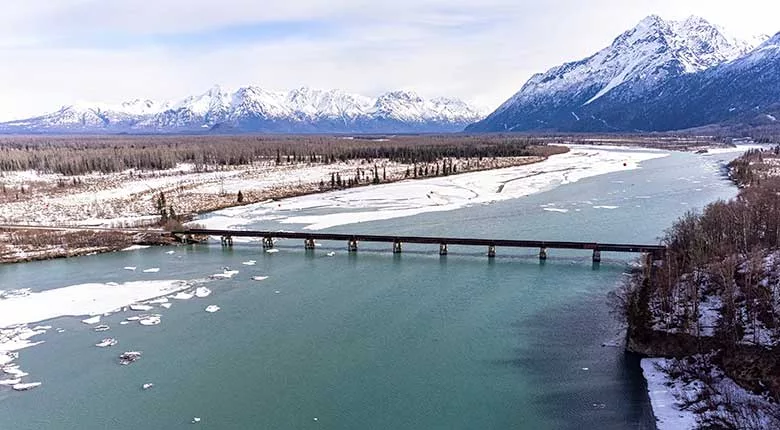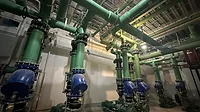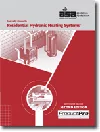CASE STUDY
New Alaskan police station locks up heating efficiency and safety with PEX hydronic systems
Radiant heating and snow- and ice-melt system provide new station with safety and reliability.

Photo courtesy of Wirestock / iStock / Getty Images Plus.
Opened in 2020, the new Wasilla police headquarters has the latest technology to supply heat and keep walkways free of ice — critical components where sub-zero temperatures and five feet of snow are common in the winter. Both the hydronic radiant heat system and the snow- and ice-melting (SIM) system consist of 5/8-inch diameter PEX barrier tubing installed in circuits in concrete slabs.
The Wasilla Police Department headquarters was a $12 million project that built a 20,000-square-foot facility, doubling the size of the previous one. The department has 28 officers, serving the city’s 9,000 residents in 13.5 square miles. Located 40 miles north of Anchorage, it is the fourth-largest city in Alaska, and one of the fastest-growing areas in the state.
“The need for efficient and cost-effective heating is a critical requirement — especially the area north of Anchorage — which typically has temperatures in the low teens to below zero during the winter months, and plenty of snow,” states Lance MacNevin, P. Eng., director of engineering for PPI's Building & Construction Division. “The outdoor design temperature in this region is below -20°F, so heating costs can be very expensive. It is a known fact that hydronic radiant heating can be as much as 40% less expensive to operate as compared to other types of heating systems. In a public facility such as this police headquarters, hydronic radiant heating checked all the boxes: reliable, comfortable, zoneable and sustainable.” PPI is the major North American trade association representing the plastic pipe industry.
 The new Wasilla police headquarters has the latest technology to supply heat and keep walkways free of ice.
The new Wasilla police headquarters has the latest technology to supply heat and keep walkways free of ice.
The systems were designed by Proctor Sales, located in Anchorage. The company also supplied all the necessary components.
“Steam isn’t available out there,” explains Tracy Adams of Proctor. “There’s still a lot of steam up in Fairbanks, but not so much down here in the Anchorage area. Electric is very expensive up here. An electric forced air furnace is going to be pretty pricey, plus you've got all the ducting that has to go in. A hydronic system is just a better way of heating. You put the tube in the floor, you fire it up, and you've got wonderful heat, great comfort.”
There are nine radiant heating zones in the two-level building controlled by nine manifolds in 52 circuits with 13,500 feet of 5/8 inch, crosslinked polyethylene (PEX-a) tubing from MrPex Systems, located in Ramsey, Minnesota. Water for the floor heating system is heated to 100° F to maintain a minimum room temperature of 68° F. Radiant zones include the patrol room, evidence storage, waiting room and training room.
Circuit lengths were designed at 240 feet to 290 feet long, depending on the room area being served. One section of the building with greater exposure used shorter circuits, just 175 feet. PEX tubing was installed by stapling it directly to 2-inch rigid foamboard insulation with an R-value of 10 before the concrete was poured. Manifolds were 1 1/4 inch diameter stainless steel headers with balancing capability.
The snow- and ice-melt system uses 12,000 feet of 5/8 inch diameter MrPEX tubing with eight 1 1/2 inch stainless steel manifolds to circulate a 50% propylene glycol solution through 51 circuits. Most manifolds are installed in concrete vaults placed in the ground. There are six snow-melting zones at multiple building entrances, including the front walkway and several side doors with a total of 7,100 square feet of outdoor surface protected. Tubing spacing for the SIM system ranges from 6 inch to 9 inch on-center, depending on the width of the areas and the expected demands, and average circuit lengths range from 125 to 290 feet, depending on the size of the area. The SIM system flow rate is designed to maintain a maximum ΔT of 25° F.
 There are nine radiant heating zones in the two-level building controlled by nine manifolds in 52 circuits with 13,500 feet of 5/8 inch, crosslinked polyethylene (PEX-a) tubing from MrPex Systems.
There are nine radiant heating zones in the two-level building controlled by nine manifolds in 52 circuits with 13,500 feet of 5/8 inch, crosslinked polyethylene (PEX-a) tubing from MrPex Systems.
Several of these SIM areas use their own snow- and ice-melt sensor controls to control flow as needed. This type of individual zoning for a SIM system is important to account for differences in wind and solar exposure to different areas of the facility and improves both safety and efficiency. The SIM system is designed to deliver up to 439,000 Btu/h at peak demand conditions.
Fluid supply is provided by a 2 Mbh condensing natural gas-fired boiler with a 20:1 turndown ratio. Snow-melting manifolds are supplied with the heated water/glycol fluid through 2-inch diameter pre-insulated PEX pipes with urethane foam insulation and a high-density polyethylene (HDPE) outer casing, buried in trenches.
Hydronic SIM systems are the ultimate in safety and reliability for outdoor surfaces, especially in challenging climates such as Alaska. For an institutional facility such as a police station, which never closes, 24/7/365 access to the building is critically important.
The company’s PEX oxygen barrier tubing is manufactured in accordance with ASTM F876 and is also certified by NSF. The barrier PEX tubing is rated by the Hydrostatic Stress Board of PPI for operation at 160 psi at 73° F and 100 psi at 180° F, and has an EVOH oxygen diffusion barrier that meets DIN 4726, the recognized standard for this property.
The outdoor design temperature in this region is below -20°F, so heating costs can be very expensive. It is a known fact that hydronic radiant heating can be as much as 40% less expensive to operate as compared to other types of heating systems. In a public facility such as this police headquarters, hydronic radiant heating checked all the boxes: reliable, comfortable, zoneable and sustainable. – LANCE MACNEVIN
“Hydronic radiant heating is a comfortable and efficient technology for a wide range of buildings” MacNevin explains. “From homes and garages to schools and large commercial and industrial facilities. In most projects, it is possible to meet the heat loss of buildings with a gently heated floor using relatively low-temperature fluid, often under 120˚F (48˚C). This gives radiant heating systems the flexibility to work with a wide variety of high-efficiency heat sources, such as low-temperature condensing boilers, geothermal water-to-water heat pumps, air-to-water heat pumps and thermal solar collection systems. Other choices include electric boilers and non-condensing boilers when proper water-temperature control devices such as mixing valves are used.”
The planning stage for designing the correct systems for the project was the key to success, Adams says. “It was important to match the loads. They need to know what size pumps, gpm and head they're going to put into the system. By designing the system with the programs our engineers use for the PEX, we were able to print out design load calculations, flow rates, head loss and other data for the project.”
More information can be found at https://plasticpipe.org/building-construction/.
Looking for a reprint of this article?
From high-res PDFs to custom plaques, order your copy today!








